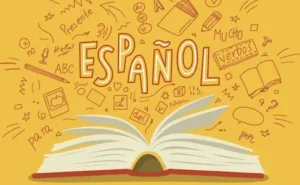Last year we talked about why learning Spanish matters. In 2022 the same trends have accelerated, with millions of English speakers in the US taking in-person and online Spanish classes for work, travel, and school, not to mention mental health and personal enrichment.
accelerated, with millions of English speakers in the US taking in-person and online Spanish classes for work, travel, and school, not to mention mental health and personal enrichment.
In fact, the popularity of platforms such as Google Classroom and Zoom have made online Spanish classes an increasingly attractive option, especially for parents and professionals keen to cut down on commuting times. Instead of driving to school from work or home, you just log in online for your Spanish class from a convenient location.
For many adults, the best way to learn Spanish is by taking communicative online classes. Despite the distances separating one another, participants in online Spanish classes can feel engaged and connected. The instructor uses an interactive student-centered methodology in the best Spanish classes.
 A lot has changed since 2020, and Spanish teachers have learned from the sudden transition to online formats and adapted. Now that they have a couple years of experience under their belts, the best Spanish instructors create online classes with a comfortable, low-pressure atmosphere that some students may prefer to in-person classes, especially after factoring in the commute.
A lot has changed since 2020, and Spanish teachers have learned from the sudden transition to online formats and adapted. Now that they have a couple years of experience under their belts, the best Spanish instructors create online classes with a comfortable, low-pressure atmosphere that some students may prefer to in-person classes, especially after factoring in the commute.
However, other learners, in contrast, feed off the energy of face-to-face interaction, hands-on materials, kinesthetic activities, and thus prefer Spanish classes on campus. While some students enjoy the organized and accessible formats like Google Classroom, other students would rather work with pen, paper, and white boards.
Both in-person and online Spanish lessons are still an option in 2022. Either way, taking group classes with experienced instructors yields better results than rote learning via phone apps and passive video watching. What you need is active participation, dynamic activities, and guided practice in a class.
Just remember, the point of learning Spanish is to communicate ideas, not avoid mistakes. It’s important to reject perfection!
Learn more about taking in-person and online Spanish classes and in-person and online French classes.
Why it still matters to learn Spanish online in 2022
Although COVID variants may throw an occasional wrench into the works, a post-pandemic normal is taking shape.
In terms of the Spanish language, tomorrow’s world will look a lot like today’s. Namely, Spanish will remain the number #2 language in the USA after English.
Consider these facts when weighing whether to take a Spanish course online or in-person:
- As of 2022, over 41 million people in the USA speak Spanish as their primary language at home. About half a billion people speak Spanish worldwide, making it the fourth most spoken language in the world.
- In terms of the 2022 job market, Spanish is increasingly important in trendingprofessions such as health care, social work, banking, human resources, and customer service. Today Mexico is the third top US trading partner (after China and Canada), making Spanish language skills increasingly valuable in international business. Heading into the hot job market of 2022, the demand will keep rising for bilingual employees.
- In terms of the global picture in 2022, trade and tourism with Spanish speaking countries continues to expand. In fact:
- In 2021 Spain was the second most popular travel destination in the world (France was #1, and Mexico was #7.) Both Spanish classes and French lessons pay off vacation-wise, allowing you to travel off the beaten path, connect with diverse people, and experience local cultures.
- Going into 2022, the Caribbean ranks among the fastest recovering tourism spots in the world, led by the Dominican Republic, where Spanish is the official language. We all know how the pandemic damaged international tourism, so it’s interesting to see which regions are bouncing back. Bottom line: now’s a great time to learn Spanish and visit the Dominican Republic.
- In terms of art and entertainment, Spanish-language content keeps growing in popularity and availability. Thanks to streaming, there’s never been a better time to watch Spanish language content. For movie and TV buffs, Netflix continues to grow its Spanish content, along with Hulu’s Latino Hub, NBC’s Peacock, Pluto TV–the list goes on. This past year saw hit series like La Casa De Papel (Money Heist) and the Oscar shortlisted film El buen patrón (The Good Boss.)
It’s never too late to learn Spanish online or on campus
While adults face challenges learning a new language, don’t get discouraged just because you’re not a kid anymore.
New research from the University of Kansas suggests that adults can learn a new language in ways similar to that of native speakers. This means even older Spanish beginners can make real progress, especially if joining Spanish classes with communicative methodology.
Research suggests that both long-term and short-term language learners experience enhanced executive functioning. Speaking, listening, writing, and reading in a new language improves your focus, memory, and cognition. Not only children benefit from bilingualism; adult language learners show improved mental flexibility, decision-making, and multi-tasking ability. Simply put, learning a language boosts your brain.
In fact, a new study from the University of Zurich on brain functioning among the elderly further demonstrates what we already know: lifelong learning staves off cognitive decline and strengthens brain functioning.
Learning a new language is never easy, but the best online Spanish course gives you lots of chances to practice speaking. All you need is a computer, Internet connection, and an interest in Spanish.
Cognates help. For instance, liberty and libertad come from the Latin libertas. Many scientific, literary, and technical terms derive from Latin roots in both Spanish and English. With greater awareness of Latin roots, you can improve your vocabulary in English too!
The best online Spanish course provides opportunities to chat, play games, and socialize. You can make small talk, discuss issues, and forge cultural connections.
Sure, you can study Spanish by watching Youtube tutorials, clicking through multiple choice exercises, and squinting at Spanish grammar textbooks. The cup of the Internet overflows with apps, videos, and grammar exercises.
That’s fine and dandy, but most people need social interaction to develop language skills. The best online Spanish classes create a welcoming community to discuss your interests, share your passions, and express a lifetime of experience in a new language.
As a mature learner, you have a lot to say. It’s both fun and beneficial to learn how to say it in a new language.
Learning how to pronounce the Spanish ‘rr’
 One of the most distinctive and beautiful aspects of the Spanish language is the rolled “rr” sound, otherwise known as the trill.
One of the most distinctive and beautiful aspects of the Spanish language is the rolled “rr” sound, otherwise known as the trill.
This famously musical sound springs to mind when we imagine a Spanish accent.
The first thing to understand is that there are actually two “r” sounds in Spanish.
Different from the trill, the simple or soft r is made by touching the roof of your mouth with the tip of your tongue ONCE. The technical term is alveolar tap, which may sound like a dance move or surgical procedure, but it actually refers to producing the simple r sound. Your tongue quickly taps the bump behind your upper front teeth at the edge of your hard palate.
The alveolar tap sounds somewhat like the “t” sound in the words waiter or otter in American English. It may also sound like a light trill, but it won’t really roll like a true trill.
You use alveolar tap to pronounce the single written letter r in three cases:
- When it occurs as the last letter, as in ir (to go).
- When it appears between two vowels, as in oro (gold).
- When it comes after any consonant except l, n, or s, such as gripe (flu) or teatro (theater).
The rules of R aren’t always set in stone. Some Spanish speakers trill the final r a word. So, on Valentine’s Day you can say mi amor with an alveolar tap or a trill—and you’ll be right (and romantic) either way.
To pronounce the Spanish trill, you touch the roof of your mouth with the tip of your tongue quickly and REPEATEDLY (not once as with the alveolar tap).
Rather than a single tap, the trill is more like a tap dance. Your tongue “rolls” on your hard palate.
Rule number one (this time set in stone) is that when a word contains two written letter rr’s, you trill to your heart’s content. That means you roll your r’s in barrio (neighborhood) and carril (lane), though not corazón (heart) with only one r.
Note how similar words such as perro (dog) and pero (but) differ. The former has a trill, the latter has a simple r.
The trill may also appear at the beginning of a word but will NEVER be spelled with two letter r’s. That means, you roll your r’s when pronouncing rojo (red), risa (laugh), and rana (frog).
Nobody’s born with the ability to trill. Children may acquire it with enviable ease, but adult Spanish learners often struggle.
With the soft r sound, you bounce your tongue off the roof of your mouth a single time. With the trill, you bounce your tongue off the roof of your mouth multiple times. Easier said than done?
Gentle press the tip of your tongue to the ridge where you pronounce the soft r–the place you pronounce the t in letter. The sound comes from there, not the throat (you’re not growling). Exhale. Don’t press too hard. But not too light. Sigh. The sound comes from the air passing over the tongue as it taps the roof of your mouth.
Practice is the best medicine. A great time to practice is right after you wake up in the morning, when your mouth muscles are relaxed and have temporarily “forgotten” their normal formation.
Here are two tongue twisters to train your tongue to trill (and do the soft r):
- Tres tristes tigres comen tres tristes platos de trigo. (Three sad tigers eat three sad plates of wheat).
- El perro de Rita me irrita. Dile a Rita que cambie el perro por una perrita. (Rita’s dog irritates me. Tell Rita to get a new dog.)
Which version of Spanish should I learn?
Similar to English, Spanish can differ among speakers depending on country, city, or socioeconomic status. There’s no single, monolithic Spanish language. Pronunciation, vocabulary, and even grammar varies among Spanish speakers worldwide, from Mexico City to Madrid.
However, the main differences boil down to two regions: Spanish in Spain or Spanish from Latin America. The differences are not huge. Folks from Spain and Mexico can understand each other, much like a Londoner and Californian are mutually intelligible.
 If you’re wondering which Spanish to learn–the Latin American version or the Spanish version–remember that the differences are slight, so it’s not a big deal, especially if you’re starting off.
If you’re wondering which Spanish to learn–the Latin American version or the Spanish version–remember that the differences are slight, so it’s not a big deal, especially if you’re starting off.
At least 90% of what you learn pertains to both kinds of Spanish. It doesn’t matter much which you study, especially if you’re learning Spanish for beginners. When choosing Spanish conversation classes, don’t worry about which Spanish to learn.
Differences among accents, vocabulary, or grammar may throw up occasional stumbling blocks, but no major obstacles. The speaking skills you develop in your online Spanish classes will let you communicate in any Spanish-speaking country.
If you have specific travel or work plans in a particular region or country, you may wish to narrow your focus as you move up to the intermediate level. Sooner or later, you may want to expose yourself to a variety of accents.
If you’re in New England, Massachusetts, or Northampton, you’re more likely to encounter Latin American Spanish. The 10 largest Hispanic origin groups—Mexicans, Puerto Ricans, Cubans, Salvadorans, Dominicans, Guatemalans, Colombians, Hondurans, Ecuadorians and Peruvians—make up over 90% of Spanish speakers in the USA. Thus, by and large, American students tend to focus on learning Latin American Spanish, while Europeans focus on Spanish from Spain.
As long as you practice the fundamentals in a dynamic online Spanish class and keep your ears open to the different accents, you’ll be prepared to communicate in most situations at home or abroad.
How long does it take to learn Spanish fluently?
Science offers no definitive answers as to how long it takes for an adult to become fluent in Spanish (or any other language.)
The U.S. State Department, however, estimates 600 class hours.
If you were to take 12 hours a week of in-person or online Spanish classes, that adds up to one year.
Of course, the greater your daily time commitment, the faster you become fluent. Regardless, achieving fluency requires resources of time and determination.
Fluency, however, may not be necessary for you to reach goals. Learning Spanish for beginners can bring great results if your immediate aim is to start socializing with Spanish-speaking colleagues in their language, understanding the lyrics of favorite Latin artists, or deepening your insights into Latino/a and Hispanic life in the US. You don’t need to be fluent to travel to Spain or Latin America and get a lot out of the experience.
beginners can bring great results if your immediate aim is to start socializing with Spanish-speaking colleagues in their language, understanding the lyrics of favorite Latin artists, or deepening your insights into Latino/a and Hispanic life in the US. You don’t need to be fluent to travel to Spain or Latin America and get a lot out of the experience.
The best online Spanish classes will give you tools to start understanding Spanish-speaking culture and communicating with people in Spanish immediately. In an effective interactive online Spanish class, you’ll learn to do things like order food, meet new neighbors, and read signs in Spanish.
The journey of a thousand miles begins with a few steps. The best online Spanish classes use a communicative approach to get you walking and talking.
Learning Spanish for beginners is a highly personalized and social process. The best online Spanish classes can get you understanding and speaking Spanish in a simple but meaningful way after just a few hours a week.
Related articles
- Great ways to learn Spanish online and why it’s important.
- Top 7 reasons to speak and learn Spanish fluently in the USA.
- Improve your listening skills in 4 easy steps!
- The Rejection of Perfection in Learning a Language
- Spanish is Darlene’s Superpower: Interview with Darlene, a Spanish language student living in the USA.
- World of jazz: Interview with Andy Jaffe, a Portuguese and Chinese language student living in the USA.
- Kathy Learning Spanish (again): Interview with a Spanish language student living in the USA.
- How Alice Flexes her Brain Through French film: Interview with a French and Spanish language student living in the USA.
- Charles the language person: Interview with an Italian and German language student living in the USA.
- Takehiro Rises: Interview with an ILI English student from Japan who built a career in the USA.
- Thinking About Human Connectivity
- #ILITips&Tricks: Staying Focused for Online Learning
- Literate Mending in Multilingual Families
- The Top 5 Benefits of Learning English Online with Native English Speaking Teachers
- A guide for beginners on how to learn Spanish
- 4 Great Reasons Why You Should Learn Spanish in the USA
